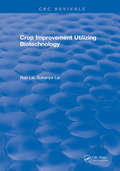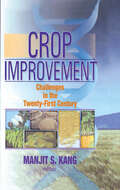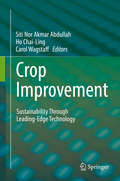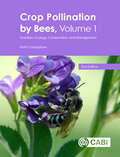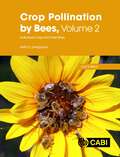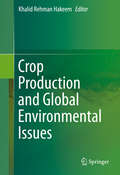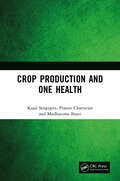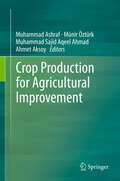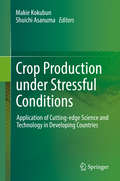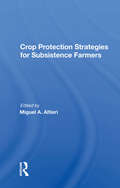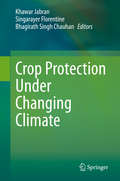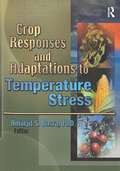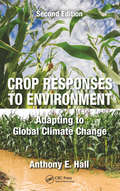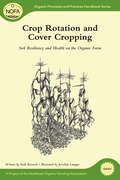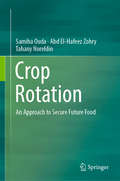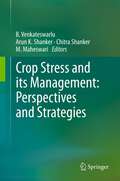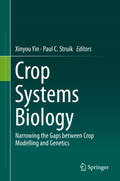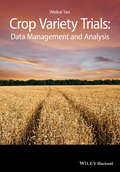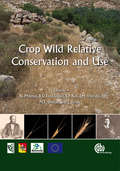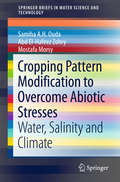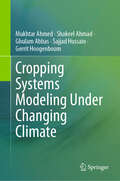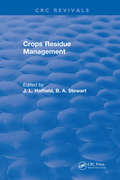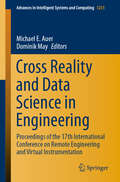- Table View
- List View
Crop Improvement Utilizing Biotechnology
by Rup LalThis book discusses; somaclonal variation in crop improvement, the role of tissue culture in rapid clonal propagation and production of pathogen-free plant, protoplasts in crop improvement, cell selection and long-term high-frequency regeneration of cereals and legumes, agrobacteria-mediated gene transformation and vectors for gene cloning in plants, and plant frost injury and its management.
Crop Improvement: Challenges in the Twenty-First Century
by Manjit S. KangLearn to integrate molecular genetic techniques with traditional plant breeding methods!This comprehensive book provides the latest authoritative scientific information on improvement of both temperate and tropical crops. Crop Improvement: Challenges in the Twenty-First Century brings together expert plant breeders and geneticists to address issues related to crop adaptability and stability across environments for important food and fiber crops. It emphasizes the need to integrate molecular genetic techniques with traditional plant breeding methods to develop hardier, more productive crops. Crop Improvement includes the latest research on physiological and biochemical responses of plants to drought and heat stress, which should help breeders develop effective strategies for improving resistance to abiotic stresses. In addition, this helpful book elucidates the use of mixed models and best linear unbiased prediction. To make the book comprehensive, chapters discuss stability analysis in crop performance trials and genotype-by-environment interactions.Crop Improvement includes detailed information on breeding specific crops, including: rice tropical maize sorghum common bean sugar beet bananas and plantain cotton Crop Improvement offers both practical information and up-to-date research. It also suggests a vision of new directions and partnerships that are expected to evolve in this century. This book is an essential resource for practicing plant breeders and geneticists at universities, government agencies, and industry. It should also be of use to teachers and students engaged in crop breeding.
Crop Improvement: Sustainability Through Leading-Edge Technology
by Siti Nor Akmar Abdullah Ho Chai-Ling Carol WagstaffThe book covers the latest development in the biosciences field covering key topics in crop improvement including 'omic approaches to improving sustainable crop production, advancement in marker technology, strategies in genetic manipulation, crop quality and sustainability and plant microbe interaction detailing on proven technologies to address critical issue for agricultural sustainability which are beneficial for researchers and students. The book also includes aspects of preserving crops after harvest as this is a key factor in promoting sustainable crop quality in terms of addressing waste, choosing the appropriate packaging and moving crops through the food and industrial supply chain. An important strategy to overcome the challenges in providing food for the world population in a sustainable manner is through concerted efforts by crop scientists to embrace new technologies in increasing yield, quality and improving food safety while minimizing adverse environmental impact of the agricultural activities. Most of the proven molecular and genetic technologies in crop science have been tested and verified in model plants such as Arabidopsis and tomato. The technologies, when deployed on various plant species of importance for human nutrition and industrial applications, including cereals, vegetables, fruits, herbs, fibre and oil crops, face many challenges, not only due to their longer life cycle but many other physiological and environmental factors affecting yield and quality of plant products. Furthermore, major impacts on crop production due to catastrophic diseases and global climate change needs urgent and innovative solutions. Therefore a systematic approach, employing various leading-edge technologies that enable the functional elucidation of key pathway genes via 'omics tools, genome wide association with desired phenotypes and development of cost effective and practicable molecular tools for selection, is vital. The International Conference on Crop Improvement was held to address these and other pressing issues. This volume summarizes the keynote presentations from the meeting and highlights addition discussions that are critical to crop improvement in a challenging time.
Crop Pollination by Bees, Volume 1: Evolution, Ecology, Conservation, and Management
by Dr Keith DelaplaneSince the second half of the 20th Century, our agricultural bee pollinators have faced mounting threats from ecological disturbance and pan-global movement of pathogens and parasites. At the same time, the area of pollinator-dependent crops is increasing globally with no end in sight. Never before has so much been asked of our finite pool of bee pollinators. This book not only explores the evolutionary and ecologic bases of these dynamics, it translates this knowledge into practical research-based guidance for using bees to pollinate crops. It emphasizes conserving wild bee populations as well as culturing honey bees, bumble bees, and managed solitary bees. To cover such a range of biology, theory, and practice from the perspectives of both the pollinator and the crop, the book is divided into two volumes. Volume 1 focuses on bees, their biology, coevolution with plants, foraging ecology and management, and gives practical ways to increase bee abundance and pollinating performance on the farm. Volume 2 (also available from CABI) focuses on crops, with chapters addressing crop-specific requirements and bee pollination management recommendations. Both volumes will be essential reading for farmers, horticulturists and gardeners, researchers and professionals working in insect ecology and conservation, and students of entomology and crop protection.
Crop Pollination by Bees, Volume 2: Individual Crops and their Bees
by Dr Keith DelaplaneSince the second half of the 20th Century, our agricultural bee pollinators have faced mounting threats from ecological disturbance and pan-global movement of pathogens and parasites. At the same time, the area of pollinator-dependent crops is increasing globally with no end in sight. Never before has so much been asked of our finite pool of bee pollinators. This book not only explores the evolutionary and ecologic bases of these dynamics, it translates this knowledge into practical research-based guidance for using bees to pollinate crops. It emphasizes conserving wild bee populations as well as culturing honey bees, bumble bees, and managed solitary bees. To cover such a range of biology, theory, and practice from the perspectives of both the pollinator and the crop, the book is divided into two volumes. Volume 1 focuses on bees, their biology, coevolution with flowering plants, foraging ecology and management, and gives practical ways to increase bee abundance and pollinating performance on the farm. Volume 2 (this volume) focuses on crops, with chapters addressing crop-specific requirements and bee pollination management recommendations. Both volumes are essential reading for farmers, horticulturists and gardeners, researchers and professionals working in insect ecology and conservation, and students of entomology and crop protection.
Crop Production and Global Environmental Issues
by Khalid Rehman HakeemMeeting the world's food security challenge will require a multi-national, collaborative effort to integrate the best research from science, engineering and socioeconomics so that technological advances can bring benefits where they are most needed. The present book covers the effect of major environmental problems on crop production and how to cope with these issues for sustainable agriculture and improvements of crops. The world's population is predicted to hit 9. 6 Billion by 2050, up from today's total of nearly 7. 3 Billion, and with it food demand is predicted to increase substantially. The post-war 'second agricultural revolution' in developed countries, and the 'green revolution' in developing nations in the mid- 1960s converted agricultural practices and elevated crop yields spectacularly, but the outcome is levelling off and will not meet projected demand. Simultaneously, crop production is affected by many other factors, including industrial pollution, overuse of fertilizers and insecticides, heavy metal and radiation stresses etc. It has been noted that many pests are becoming resistant to insecticides. Estimates vary, but around 25% of crops can be lost to pests and diseases. Climate change associated with agriculture is also a global issue. Agriculture is a significant contributor to greenhouse gases and is estimated to account for 10-12% of total greenhouse gas (GHG) emissions. Many of the issues highlighted are global problems and are addressed thoroug hly in this work.
Crop Production and One Health
by Prasun Chatterjee Kajal Sengupta Madhurima BauriThe subject matter of this book focuses on recognizing the relationship between humans, animals, plants, and their environment to attain optimum health results. The key objectives of ‘One Health’ are to identify and track the numerous risk factors, the system’s strengths, and weaknesses that can further reduce the risk factors’ rising effects and promote several eco-friendly and more sustainable choices.Considering all the elements of 'One Health' in one location, this book also explains its four key components which are – the geographical component, the ecological component, the human activities component and the food and agricultural component. Print edition not for sale in South Asia (India, Sri Lanka, Nepal, Bangladesh, Pakistan and Bhutan)
Crop Production for Agricultural Improvement
by Münir Öztürk Muhammad Ashraf Ahmet Aksoy Muhammad Sajid AhmadIn the recent years, the looming food scarcity problem has highlighted plant sciences as an emerging discipline committed to devise new strategies for enhanced crop productivity. The major factors causing food scarcity are biotic and abiotic stresses such as plant pathogens, salinity, drought, flooding, nutrient deficiency or toxicity which substantially limit crop productivity world-wide. In this scenario, strategies should be adopted to achieve maximum productivity and economic crop returns. In this book we have mainly focused on physiological, biochemical, molecular and genetic bases of crop development and related approaches that can be used for crop improvement under environmental adversaries. In addition, the adverse effects of different biotic (diseases, pathogens etc.) and abiotic (salinity, drought, high temperatures, metals etc) stresses on crop development and the potential strategies to enhance crop productivity under stressful environments are also discussed.
Crop Production under Stressful Conditions: Application of Cutting-edge Science and Technology in Developing Countries
by Makie Kokubun Shuichi AsanumaThis book presents field studies on crop production in developing countries such as Vietnam, Kenya, Namibia, Colombia, Afghanistan and Sudan. Further, it examines the achievements of SATREPS, a development assistance program sponsored by the Japanese government that promotes international joint research to address these global issues. In this context, multidisciplinary research teams consisting of breeders, physiologists, soil scientists, agronomists, and other scientists related to agricultural development worked together to tackle the challenges involved in enhancing the capacity of crop production in the respective regions. In addition to presenting novel scientific findings, this book highlights practical field studies that verify the effectiveness of the scientific findings in actual environments. The achievements will help to improve crop production worldwide, and the lessons learnt will be useful in re-designing strategies to address global issues in crop production, particularly in developing regions. Lastly, the outcomes discussed will be useful to policymakers and professionals engaged in crop production and food security in developing countries, as well as researchers and students.
Crop Protection Strategies For Subsistence Farmers
by Miguel A AltieriTop-down approaches to pest management, relying on agrochemical inputs that can be scarce, expensive, ecologically toxic, or inaccessible, have repeatedly failed to solve pest problems that affect small farmers in developing countries. Crop Protection Strategies for Subsistence Farmers offers an alternative. Drawing on examples from Latin Am
Crop Protection Under Changing Climate
by Khawar Jabran Bhagirath Singh Chauhan Singarayer FlorentineThis book addresses the impact of important climatic changes on plant pests (including weeds, diseases and insect pests), and their interactions with crop plants. Anthropogenic activities have seriously impacted the global climate. As a result, carbon dioxide (CO2) and temperature levels of the earth are on a continuous rise. The global temperature is expected to increase by a 3°C or more by the end of this century. The CO2 concentration was below 300 parts per million (ppm) before the start of the industrial era; however, recently it has exceeded 400 ppm. This is highest ever in human history. Other than global warming and elevated CO2 concentrations, anthropogenic activities have also disturbed the global water cycle, ultimately, impacting the quantity and distribution of rainfall. This has resulted in drought conditions in many parts of the world. Global warming, elevated CO2 concentration and drought are considered the most important recent climatic changes that are impacting global ecosystems and human societies. Among other impacts, the effects of climatic changes on pests, pest-crop interactions and pest control are important with relevance to global food security, and hence require immediate attention by plant scientists. This book discusses innovative and the most effective pest control methods under an environment of changing climate and elaborates on the impact of drought on plant pests and their control.
Crop Responses and Adaptations to Temperature Stress: New Insights and Approaches
by Amarjit S. BasraExamine the ways in which various plants respond when exposed to high and low temperatures!The growing demand for food makes breeding for high-yielding crops with built-in resistance against environmental constraints one of the most important challenges for plant breeders today. Crop Responses and Adaptations to Temperature Stress investigates the adaptive mechanisms plants have evolved in response to unfavorable temperature conditions. It describes gene transfer technology and other tolerance improvement techniques that aid in developing stress-tolerant plants.Adverse environmental stress conditions, such as extreme temperatures, affect the productivity of important world food crops by inhibiting plant growth and development. Crop Responses and Adaptations to Temperature Stress provides valuable information on the mechanisms of stress tolerance in plants that encourage growth and enhance yield performance.Agriculture professionals, researchers, and plant breeders will benefit from the ideas shared on such topics as: mechanisms of chilling injury and tolerance injury and acclimation of root system functions during chilling temperatures mechanisms of cold acclimation signal transduction under low-temperature stress mechanisms of thermotolerance in crops control of the heat shock response in crop plants the effects of heat stress on cereal yield and qualityCrop Responses and Adaptations to Temperature Stress presents detailed discussions on the effects and outcomes of crop exposure to low and high temperatures. The textual information is liberally supplemented with visual representations of field experiment data as well as comprehensive tables and schematic drawings.In addition to a detailed review of current knowledge on the molecular biology of plant responses to temperature stress and an introduction to biotechnological advances in improving crop tolerance, Crop Responses and Adaptations to Temperature Stress suggests avenues for further study and speculates on the implications of such work for the future of food production.
Crop Responses to Environment: Adapting to Global Climate Change, Second Edition
by Anthony E. HallFollowing in the tradition of its predecessor, Crop Responses to Environment, this fully updated and more comprehensive second edition describes aspects of crop responses to environment that are particularly relevant to the development of improved crop cultivars and management methods on a global scale. It includes an extensive discussion of the difficulties in developing agricultural systems that accommodate increasing human needs for agricultural products during the twenty-first century in a sustainable manner. The book features new sections on adaptation to global climate change including adapting to global warming, elevated atmospheric carbon dioxide concentration, and increased flooding and salinity through plant breeding and changes in crop management. Warming effects include stressful effects of heat on pollen development and reduced winter chilling effects on fruit and nut trees. The book examines principles, theories, mathematical models, and experimental observations concerning plant responses to environment that are relevant to the development of improved crop cultivars and management methods. It illustrates the importance of considering emergent plant properties as well as reductionist approaches to understanding plant function and adaptation. Plant physiological and developmental responses to light and temperature, and plant water relations are considered in detail. Dr. Hall also describes climatic zone definitions based on temperature, rainfall, and evaporative demand in relation to plant adaptation and the prediction of crop water use. Irrigation management and crop responses to salinity, flooding and toxic levels of boron and aluminum are considered. Crop responses to pests and diseases as they interact with crop responses to physical and chemical aspects of the environment are examined. The book concludes with analyses illustrating the relevance of crop responses to environment to plant breeding.
Crop Rotation and Cover Cropping: Soil Resiliency and Health on the Organic Farm
by Seth KroeckIn Crop Rotation and Cover Cropping, you can learn some of the thinking behind—and the actual nuts and bolts of—laying out a rotation for your farm. This volume, part of the NOFA guides, covers:Historical roots of cover-crop techniquesThinking beyond this season's cash crop (disease and pest reduction, weed suppression, cash vs. cover crops)What is a good rotation? (mapping the farm, grouping crops, sample groupings)The economics of rotations and cover cropping (organizing your work, reducing labor inputs, land and cover-crop seed costs)Including on-farm examples and detailed appendices.
Crop Rotation: An Approach to Secure Future Food
by Samiha Ouda Abd El-Hafeez Zohry Tahany NoreldinThis book tackles the issue of using crop rotation to increase food production and secure it for the growing population of the future. Crop rotation can be a solution of food gaps in the developing counties. Crop rotation plays an important role in attaining soil sustainability and in controlling pests and weeds. It can alleviate damage caused by climate change by reducing losses in productivity of the crops, minimizing soil fertility loss and increase irrigation water productivity. This book also includes the reviews of a large number of crop rotations that have been published internationally, and additionally, the crop rotations that have been implemented in Egypt have a unique characteristic to them and therefore, a large number of those reviews have also been included.
Crop Stress and its Management: Perspectives And Strategies
by Chitra Shanker B. Venkateswarlu Arun K. Shanker M. MaheswariCrops experience an assortment of environmental stresses which include abiotic viz., drought, water logging, salinity, extremes of temperature, high variability in radiation, subtle but perceptible changes in atmospheric gases and biotic viz., insects, birds, other pests, weeds, pathogens (viruses and other microbes). The ability to tolerate or adapt and overwinter by effectively countering these stresses is a very multifaceted phenomenon. In addition, the inability to do so which renders the crops susceptible is again the result of various exogenous and endogenous interactions in the ecosystem. Both biotic and abiotic stresses occur at various stages of plant development and frequently more than one stress concurrently affects the crop. Stresses result in both universal and definite effects on plant growth and development. One of the imposing tasks for the crop researchers globally is to distinguish and to diminish effects of these stress factors on the performance of crop plants, especially with respect to yield and quality of harvested products. This is of special significance in view of the impending climate change, with complex consequences for economically profitable and ecologically and environmentally sound global agriculture. The challenge at the hands of the crop scientist in such a scenario is to promote a competitive and multifunctional agriculture, leading to the production of highly nourishing, healthy and secure food and animal feed as well as raw materials for a wide variety of industrial applications. In order to successfully meet this challenge researchers have to understand the various aspects of these stresses in view of the current development from molecules to ecosystems. The book will focus on broad research areas in relation to these stresses which are in the forefront in contemporary crop stress research.
Crop Systems Biology: Narrowing the gaps between crop modelling and genetics
by Xinyou Yin Paul C. StruikThe sequencing of genomes has been completed for an increasing number of crop species, and researchers have now succeeded in isolating and characterising many important QTLs/genes. High expectations from genomics, however, are waving back toward the recognition that crop physiology is also important for realistic improvement of crop productivity. Complex processes and networks along various hierarchical levels of crop growth and development can be thoroughly understood with the help of their mathematical description - modelling. The further practical application of these understandings also requires quantitative predictions. In order to better support design, engineering and breeding for new crops and cultivars for improving agricultural production under global warming and climate change, there is an increasing call for an interdisciplinary research approach, which combines modern genetics and genomics, traditional physiology and biochemistry, and advanced bioinformatics and modelling. Such an interdisciplinary approach has been practised in various research groups for many years. However, it does not seem to be fully covered in the format of book publications. We want to initiate a book project on crop systems biology - narrowing the gaps between genotypes and phenotypes and the gaps between crop modelling and genetics/genomics, for publication in 2013/2014. The book will be meant for those scientists and graduate students from fundamental plant biology and applied crop science who are interested in bridging the gap between these two fields. We have invited a group of scientists (who have very good track records in publishing excellent papers in this field or in a closely related area) to contribute chapters to this new book, and they have agreed to do so.
Crop Variety Trials
by Weikai YanVariety trials are an essential step in crop breeding and production. These trials are a significant investment in time and resources and inform numerous decisions from cultivar development to end-use. Crop Variety Trials: Methods and Analysis is a practical volume that provides valuable theoretical foundations as well as a guide to step-by-step implementation of effective trial methods and analysis in determining the best varieties and cultivars.Crop Variety Trials is divided into two sections. The first section provides the reader with a sound theoretical framework of variety evaluation and trial analysis. Chapters provide insights into the theories of quantitative genetics and principles of analyzing data. The second section of the book gives the reader with a practical step-by-step guide to accurately analyzing crop variety trial data. Combined these sections provide the reader with fuller understanding of the nature of variety trials, their objectives, and user-friendly database and statistical tools that will enable them to produce accurate analysis of data.
Crop Wild Relative Conservation and Use
by Nigel Maxted E. Dulloo J. Irinodo S. P. Keller J. Turok B. V. Ford-LloydCrop wild relatives are the natural genetic progenitors of plant species that humans cultivate and consume every day. This massive and thorough textbook covers many of the scientific efforts used to conserve and utilize these species, including in situ management, genetic and hybrid research and the prevention of natural and man-made factors that can limit or destroy crops. Specific case examples are presented from around the world, showing how agricultural science has progressed in this area, and how pollution and population growth have set this progress back. The text is dense and aimed at those already proficient at agri-science, but a more comprehensive study of crop wild relatives would be hard to imagine. Three of the six editors are affiliated with the school of biosciences, U. of Birmingham, UK; two are with Bioversity International, Rome, Italy; and one is with the U. Rey Juan Carlos, Madrid, Spain. Contributors of the 49 chapters are from many countries, and the final two chapters discuss global conservation issues.
Cropping Pattern Modification to Overcome Abiotic Stresses: Water, Salinity and Climate (SpringerBriefs in Water Science and Technology)
by Abd El-Hafeez Zohry Samiha A. H. Ouda Mostafa MorsyThis book provides state-of-the art analysis, never done before in Egypt, on agro-climatic zones level. This study deals with how the national cropping pattern can be modified to overcome abiotic stresses, such as water scarcity, induced salinity and climate change to reduce their negative effects on food production. To this end, different cropping patterns are suggested. This study can be a framework for other developing countries to be used in quantifying and filling the gap in their knowledge about practices that can help in increasing their food security through increasing food production. Furthermore, the study is useful for policy makers to help them in their future plans and policies.
Cropping Systems Modeling Under Changing Climate
by Gerrit Hoogenboom Mukhtar Ahmed Ghulam Abbas Sajjad Hussain Shakeel AhmadThis book aims at bringing out comprehensive information on cropping systems modelling in the world. The major focus of this book is to address the integration of soil, plant and environmental interactions for climate smart agriculture. This book covers aspects of application of Decision Support System for Agrotechnology Transfer (DSSAT) for climate smart agriculture. Step-by-step details of application of modelling approaches used for various cropping systems under changing climate are provided which are being adopted by farmers in the world. The book is enriched with figures or diagrams to show the various mechanisms involved to support the decision making for climate change adaptations. Essential information is given regarding crop models calibration, evaluation and application and every individual chapter is comprised of a specific cropping system. Further contents include integration of climate models and crop models for refining the decisions for sustaining the production of various cropping systems for climate smart agriculture. This book assists the agricultural scientists involved in research regarding climate smart agriculture for improving the standards of agricultural research for ensuring food security under changing climate. This is also equally useful for policy makers being involved in future planning.
Crops Residue Management
by J. L. HatfieldRecent changes in the Conservation Compliance Plans for farmers shows the need for improved information on the effective management of crop residues. Residue management requires an understanding of the crop, soil, and climate in which the farming system is located. In this volume, the strategies for effective residue management are described for each region of the country to provide a comparison of the regional differences. The chapters not only describe the knowledge in each region but also suggest some of the needed areas of research required to develop an improved understanding of the processes involved in effective residue management.
Cross Fire: An Exo Novel (The Exo Novels)
by Fonda Lee“Cross Fire, like Exo, is a knockout . . . Lee’s recalibrating of traditional YA dystopian narratives continues to be a strength.” —MuggleNetIt’s time to take back Earth.Earth’s century of peace as a colony of an alien race has been shattered. As the alien-run government navigates peace talks with the human terrorist group Sapience, Donovan tries to put his life back together and return to his duty as a member of the security forces. But a new order comes from the alien home planet: withdraw. Earth has proven too costly and unstable to maintain as a colony, so the aliens, along with a small selection of humans, begin to make plans to leave. As word of the withdrawal spreads through the galaxy, suddenly Earth becomes vulnerable to a takeover from other alien races. Aliens who do not seek to live in harmony with humans, but will ravage and destroy the planet.As a galactic invasion threatens, Donovan realizes that Sapience holds the key that could stop the impending war. Yet in order to save humankind, all species on Earth will have to work together, and Donovan might just have to make the ultimate sacrifice to convince them.“Brutal, intense action scenes . . . ultimately wins through to a hard-fought triumph.” —Kirkus Reviews“Cross Fire is a solid sequel to Exo and maintains the exciting pace, twisty plot, and ethical quandaries.” —Fantasy Literature
Cross Kill: An Alex Cross Story (An Alex Cross Story #1)
by James PattersonAlex Cross, I'm coming for you--even from the grave if I have to. Along Came a Spider killer Gary Soneji has been dead for over ten years. Alex Cross watched him die. But today, Cross saw him gun down his partner. Is Soneji alive? A ghost? Or something even more sinister? <P>Nothing will prepare you for the wicked truth. <P><b>A New York Times Bestseller</b>
Cross Reality and Data Science in Engineering: Proceedings of the 17th International Conference on Remote Engineering and Virtual Instrumentation (Advances in Intelligent Systems and Computing #1231)
by Michael E Auer Dominik MayToday, online technologies are at the core of most fields of engineering and society as a whole . This book discusses the fundamentals, applications and lessons learned in the field of online and remote engineering, virtual instrumentation, and other related technologies like Cross Reality, Data Science & Big Data, Internet of Things & Industrial Internet of Things, Industry 4.0, Cyber Security, and M2M & Smart Objects.Since the first Remote Engineering and Virtual Instrumentation (REV) conference in 2004, the event has focused on the use of the Internet for engineering tasks, as well as the related opportunities and challenges. In a globally connected world, interest in online collaboration, teleworking, remote services, and other digital working environments is rapidly increasing. In this context, the REV conferences discuss fundamentals, applications and experiences in the field of Online and Remote Engineering as well as Virtual Instrumentation. Furthermore, the conferences focus on guidelines and new concepts for engineering education in higher and vocational education institutions, including emerging technologies in learning, MOOCs & MOOLs, and open resources.This book presents the proceedings of REV2020 on “Cross Reality and Data Science in Engineering” which was held as the 17th in series of annual events. It was organized in cooperation with the Engineering Education Transformations Institute and the Georgia Informatics Institutes for Research and Education and was held at the College of Engineering at the University of Georgia in Athens (GA), USA, from February 26 to 28, 2020.
